
Sorbus is a genus of over 100 species of trees and shrubs in the rose family, Rosaceae. Species of Sorbus (s.l.) are commonly known as whitebeam, rowan (mountain-ash) and service tree. The exact number of species is disputed depending on the circumscription of the genus, and also due to the number of apomictic microspecies, which some treat as distinct species, but others group in a smaller number of variable species. Recent treatments classify Sorbus in a narrower sense to include only the pinnate leaved species of subgenus Sorbus, raising several of the other subgenera to generic rank.
Ironwood is a common name for many woods or plants that have a reputation for hardness, or specifically a wood density that is heavier than water, although usage of the name ironwood in English may or may not indicate a tree that yields such heavy wood.
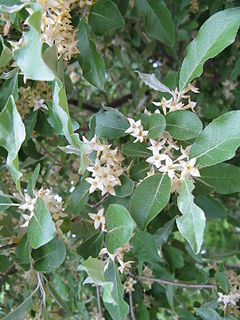
Elaeagnus umbellata is known as Japanese silverberry, umbellata oleaster, autumn olive, autumn elaeagnus, or spreading oleaster. The species is indigenous to eastern Asia and ranges from the Himalayas eastwards to Japan. It is a hardy, aggressive invasive species able to readily colonize barren land, becoming a troublesome plant in the central and northeastern United States and Europe.
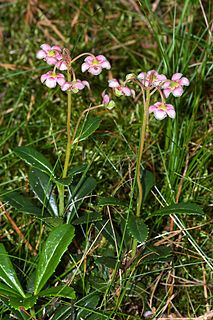
Chimaphila umbellata, the umbellate wintergreen, pipsissewa, or prince's pine, is a small perennial flowering plant found in dry woodlands, or sandy soils. It is native throughout the cool temperate Northern Hemisphere.

Acacia, commonly known as the wattles or acacias, is a large genus of shrubs and trees in the subfamily Mimosoideae of the pea family Fabaceae. Initially, it comprised a group of plant species native to Africa and Australasia, but it has now been limited to contain only the Australasian species. The genus name is New Latin, borrowed from the Greek ἀκακία, a term used by Dioscorides for a preparation extracted from the leaves and fruit pods of Vachellia nilotica, the original type of the genus. In his Pinax (1623), Gaspard Bauhin mentioned the Greek ἀκακία from Dioscorides as the origin of the Latin name.

Abronia umbellata is a flowering annual plant which is native to western North America. Other common names include beach sand verbena and purple sand verbena.
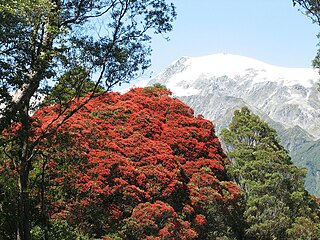
Metrosideros umbellata, the southern rātā, is a tree endemic to New Zealand. It grows up to 15 metres (49 ft) or more tall with a trunk up to 1 metre or more in diameter. It produces masses of red flowers in summer. Unlike its relative, northern rātā, this species rarely grows as an epiphyte.

Comandra is a monotypic genus containing the single species Comandra umbellata. Its common names include bastard toadflax, umbellate bastard toadflax, and common comandra. The plant has a disjunct distribution; its four subspecies occur in North America and the Mediterranean.

Grevillea obtecta is a spreading shrub which is endemic to Victoria, Australia. It is known by the common names Fryerstown grevillea, Elphinstone grevillea, or Taradale grevillea. It grows to 0.5 metres in height and about 1.2 m in width The flowers, which are light green to yellow, appear between August and November in its native range.

Calyptridium umbellatum, synonym Cistanthe umbellata, is a species of flowering plant in the montia family known by the common name Mount Hood pussypaws or — especially outside the Pacific Northwest — simply pussy-paws.
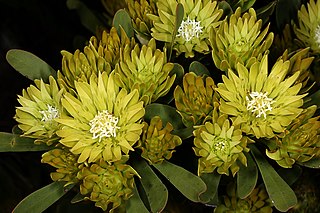
Aulax is a South African Proteaceae genus of just three species of evergreen shrubs commonly known as "featherbushes". It is unusual among the many South African Proteaceae in having male and female flowers on separate plants. The bushes have fine needle-like foliage. In spring and summer female plants produce funnel-shaped Leucospermum-like flowerheads that develop into seed cones. The catkin-like male flowers are yellow.

Melochia umbellata is a species of flowering plant in the mallow family, Malvaceae. Its specific epithet comes from the Latin umbellatus (umbel-like), referring to the inflorescence.

Iberis umbellata, common name garden candytuft or globe candytuft, is a herbaceous annual flowering plant of the genus Iberis and the family Brassicaceae.
Hunteria umbellata grows as either a shrub or small tree up to 22 metres (72 ft) tall, with a trunk diameter of up to 40 centimetres (16 in). Its flowers feature a white, creamy or pale yellow corolla. The fruit is yellow and smooth. Its habitat is forests from sea level to 600 metres (2,000 ft) altitude. Its numerous local medicinal uses include for fever, leprosy sores, stomach and liver problems and as an anthelmintic, especially against internal worms. Hunteria umbellata has been used as arrow poison. The plant's hard wood is used in carving and to make small tools. The species is native to an area of tropical Africa from Guinea-Bissau in the west to Angola in the south.

Prunus umbellata, called flatwoods plum, hog plum and sloe plum, is a plum species native to the United States from Virginia, south to Florida, and west to Texas.

Doellingeria umbellata, known by the common names tall flat-topped white aster, parasol whitetop, or tall white-aster, is a North American plant species in the aster family. It is native to Canada, St. Pierre and Miquelon, and the eastern and north-central United States (from Nebraska and the Dakotas east to Maine and South to Mississippi, Georgia and the Florida Panhandle.
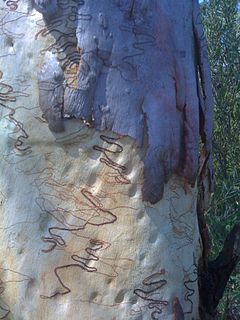
Caravan Head Bushland Reserve is a reserve approximately 2.2ha located in Sutherland Shire, southern Sydney, in the state of New South Wales, Australia.

Acacia acradenia, commonly known as Velvet Hill wattle and silky wattle, is a shrub or tree belonging to the genus Acacia and the subgenus Juliflorae. It is native to northern and central Australia. The Indigenous Australian group the Nyangumarta peoples know it as walypuna the Alyawarr call it ampwey, the Jaminjung and Ngaliwurru know it as Mindiwirri, the Jaru as binbali or gundalyji, the Kaytetye as ampweye or arwele and the Warlpiri as ngardurrkura.
Corymbia calophylla – Xanthorrhoea preissii woodlands and shrublands of the Swan Coastal Plain is an ecological community in the Southwest Australia ecoregion.
















